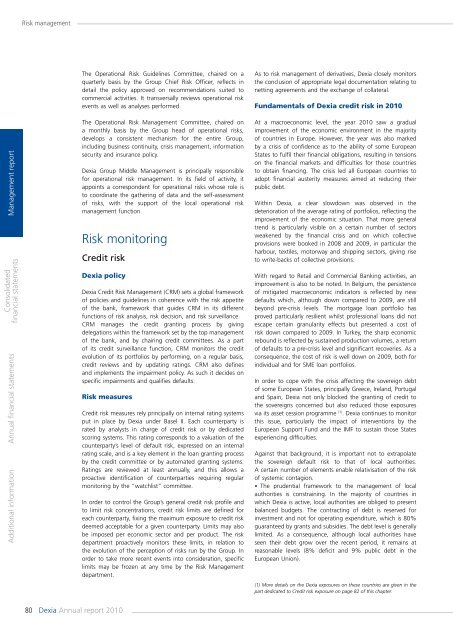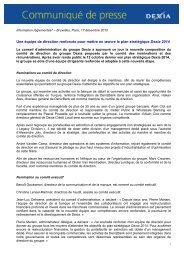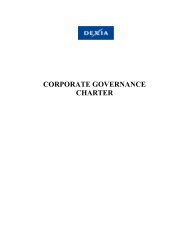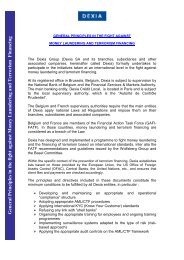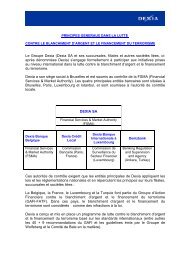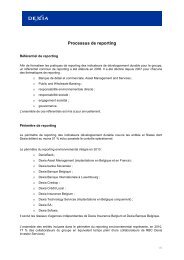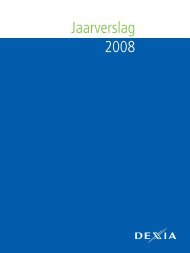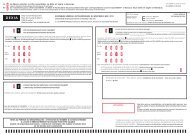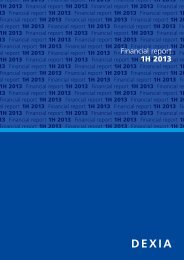Risk managementThe Operational Risk Guidelines Committee, chaired on aquarterly basis by the Group Chief Risk Officer, reflects indetail the policy approved on re<strong>com</strong>mendations suited to<strong>com</strong>mercial activities. It transversally reviews operational riskevents as well as analyses performed.As to risk management of derivatives, <strong>Dexia</strong> closely monitorsthe conclusion of appropriate legal documentation relating tonetting agreements and the exchange of collateral.Fundamentals of <strong>Dexia</strong> credit risk in <strong>2010</strong>Management <strong>report</strong>Consolidatedfinancial statementsAdditional information <strong>Annual</strong> financial statementsThe Operational Risk Management Committee, chaired ona monthly basis by the Group head of operational risks,develops a consistent mechanism for the entire Group,including business continuity, crisis management, informationsecurity and insurance policy.<strong>Dexia</strong> Group Middle Management is principally responsiblefor operational risk management. In its field of activity, itappoints a correspondent for operational risks whose role isto coordinate the gathering of data and the self-assessmentof risks, with the support of the local operational riskmanagement function.Risk monitoringCredit risk<strong>Dexia</strong> policy<strong>Dexia</strong> Credit Risk Management (CRM) sets a global frameworkof policies and guidelines in coherence with the risk appetiteof the bank, framework that guides CRM in its differentfunctions of risk analysis, risk decision, and risk surveillance.CRM manages the credit granting process by givingdelegations within the framework set by the top managementof the bank, and by chairing credit <strong>com</strong>mittees. As a partof its credit surveillance function, CRM monitors the creditevolution of its portfolios by performing, on a regular basis,credit reviews and by updating ratings. CRM also definesand implements the impairment policy. As such it decides onspecific impairments and qualifies defaults.Risk measuresCredit risk measures rely principally on internal rating systemsput in place by <strong>Dexia</strong> under Basel II. Each counterparty israted by analysts in charge of credit risk or by dedicatedscoring systems. This rating corresponds to a valuation of thecounterparty’s level of default risk, expressed on an internalrating scale, and is a key element in the loan granting processby the credit <strong>com</strong>mittee or by automated granting systems.Ratings are reviewed at least annually, and this allows aproactive identification of counterparties requiring regularmonitoring by the “watchlist” <strong>com</strong>mittee.In order to control the Group’s general credit risk profile andto limit risk concentrations, credit risk limits are defined foreach counterparty, fixing the maximum exposure to credit riskdeemed acceptable for a given counterparty. Limits may alsobe imposed per economic sector and per product. The riskdepartment proactively monitors these limits, in relation tothe evolution of the perception of risks run by the Group. Inorder to take more recent events into consideration, specificlimits may be frozen at any time by the Risk Managementdepartment.At a macroeconomic level, the year <strong>2010</strong> saw a gradualimprovement of the economic environment in the majorityof countries in Europe. However, the year was also markedby a crisis of confidence as to the ability of some EuropeanStates to fulfil their financial obligations, resulting in tensionson the financial markets and difficulties for those countriesto obtain financing. The crisis led all European countries toadopt financial austerity measures aimed at reducing theirpublic debt.Within <strong>Dexia</strong>, a clear slowdown was observed in thedeterioration of the average rating of portfolios, reflecting theimprovement of the economic situation. That more generaltrend is particularly visible on a certain number of sectorsweakened by the financial crisis and on which collectiveprovisions were booked in 2008 and 2009, in particular theharbour, textiles, motorway and shipping sectors, giving riseto write-backs of collective provisions.With regard to Retail and Commercial Banking activities, animprovement is also to be noted. In Belgium, the persistenceof mitigated macroeconomic indicators is reflected by newdefaults which, although down <strong>com</strong>pared to 2009, are stillbeyond pre-crisis levels. The mortgage loan portfolio hasproved particularly resilient whilst professional loans did notescape certain granularity effects but presented a cost ofrisk down <strong>com</strong>pared to 2009. In Turkey, the sharp economicrebound is reflected by sustained production volumes, a returnof defaults to a pre-crisis level and significant recoveries. As aconsequence, the cost of risk is well down on 2009, both forindividual and for SME loan portfolios.In order to cope with the crisis affecting the sovereign debtof some European States, principally Greece, Ireland, Portugaland Spain, <strong>Dexia</strong> not only blocked the granting of credit tothe sovereigns concerned but also reduced those exposuresvia its asset cession programme (1) . <strong>Dexia</strong> continues to monitorthis issue, particularly the impact of interventions by theEuropean Support Fund and the IMF to sustain those Statesexperiencing difficulties.Against that background, it is important not to extrapolatethe sovereign default risk to that of local authorities.A certain number of elements enable relativisation of the riskof systemic contagion.• The prudential framework to the management of localauthorities is constraining. In the majority of countries inwhich <strong>Dexia</strong> is active, local authorities are obliged to presentbalanced budgets. The contracting of debt is reserved forinvestment and not for operating expenditure, which is 80%guaranteed by grants and subsidies. The debt level is generallylimited. As a consequence, although local authorities haveseen their debt grow over the recent period, it remains atreasonable levels (8% deficit and 9% public debt in theEuropean Union).(1) More details on the <strong>Dexia</strong> exposures on these countries are given in thepart dedicated to Credit risk exposure on page 82 of this chapter.80 <strong>Dexia</strong> <strong>Annual</strong> <strong>report</strong> <strong>2010</strong>
Risk management• Numerous mechanisms protect local authority debt holders(in France and Belgium, they are obliged to reserve theamounts necessary to service the debt; in Italy, creditors ofpublic debt benefit from a priority right to tax revenues, andso on).Local authorities have nonetheless been globally hit by thedeterioration of the world economy, rather heterogeneouslydepending upon the country concerned. Indeed, Japanwas somewhat sheltered from the crisis, local authoritiesnot appearing to be significantly impacted. Turkey was notaffected by the recession and most major metropolitan citiesretain good savings capacity. The reactions and measurestaken by governments play a significant role. Some authoritiesreceive a major proportion of their receipts from centralgovernment. The increase of transfers, either ad hoc as inPoland or through the introduction of recovery plans as in theUnited States, offset the fall of tax receipts.In Spain, a clear increase of the level of debt and a pronounceddeterioration of gross savings levels are to be noted for someregions, whilst in view of land registry revisions the <strong>com</strong>muneshave posted an increase of receipts. In Italy, debt is likely tostabilise but pressures on health expenditure remain severe.In Eastern Europe, the impact of the crisis is rather markedin Bulgaria, the Czech Republic and Hungary through a fallin tax receipts but this is offset by increased governmentsubsidies. No pronounced effect is observed at this stagein Romania. In Poland, the crisis is hardly visible on currentauthority receipts but savings are falling and investmentremains sustained. In France, the sharp increase in transferduty products has helped in coping with the slowdown ofother operational resources. <strong>2010</strong> was a year of transition fordirect local taxation, marked by the abolition of local businesstax. Government grants hardly evolved at all and are likelyto remain frozen for three years. Investment fell slightly butremains at a high level. There is a risk that the impact ofthese different measures will particularly affect Départementswhich on the one hand are deprived of the momentum oftheir fiscal resources and on the other hand must deal with asustained increase in social action expenditure, particularly byvirtue of Active Solidarity In<strong>com</strong>e (Revenu de solidarité active,RSA), which will have a potential impact on their internalrating, although it will nonetheless remain sound. In Belgium,affected by the economic and financial crisis, budgets revealeda weakening in 2009 of the financial situation of numerousBelgian municipalities. Results demonstrate a relativestabilisation in <strong>2010</strong> <strong>com</strong>pared to the situation in 2009. Therate of growth of receipts for the financial year (2.2%) is wellabove the forecast expenditure rate (1.6%). In general, localadministrations have a funding structure which is relatively lessdirectly sensitive to the evolution of the economic situation. Inthe USA, the federal States have budgets which are difficultto conclude but are more frequently obliged by the law tobe balanced. Authorities have therefore made significantreductions to their expenditure.<strong>Dexia</strong> pursued its bond cession programme in <strong>2010</strong>, in linewith the undertakings made to the European Commission,resulting mechanically in a reduction of the Group’s credit risk.On that portfolio, the impact of the crisis continued to weighon the average rating level, although no clear deteriorationwas observed in terms of performance or expected loss. Thedeterioration is more pronounced in Residential Mortgage-Backed Securities (RMBS) segments in the United States andin Europe, principally in Ireland and Spain. The bond portfolioremains nonetheless characterized by very good credit quality,with 95% at Investment Grade level.In general, the good resistance shown by the <strong>Dexia</strong> assetbase to the economic crisis confirms the low risk profile ofthe Group’s business lines.Financial Products portfolio (1)In <strong>2010</strong>, the Financial Products portfolio was reduced byUSD 1.6 billion, to USD 13.8 billion (nominal value), due toUSD 0.4 billion asset sales and to the amortization of theportfolio. As at 31 December <strong>2010</strong>, the expected average lifeof the portfolio is 9.2 years.In a context characterized by a volatile economic environmentand large stocks of homes which will continue to weigh heavilyon the real estate market, at least in 2011, <strong>Dexia</strong> adapted itsUS RMBS scenario to take the following considerations intoaccount.• During <strong>2010</strong>, a high percentage of delinquent loans, inparticular subprime loans, have been restructured by theservicers, and this has contributed to an improvement of thedefault rate on such assets. However, <strong>Dexia</strong> estimates that aproportion of these defaults could just be postponed in time.• Visibility on housing price recovery remains low due to theexisting large stock of homes for sale and to other negativefactors such as the impact of a potential foreclosure freeze.<strong>Dexia</strong> therefore proceeded to make some adjustments to itsassumptions for US RMBS. In particular, to reflect the assessedimpact of loan modifications, <strong>Dexia</strong> assumes that the currentdefault rates will not improve within the next 3 years andmight need 4 additional years to return to the levels observedbefore the crisis arose. Moreover, <strong>Dexia</strong> assumes that currentseverity rates (2) will not show any improvement until the endof the transactions.Based on these elements, projected economic losses wouldincrease to USD 1,796 million under <strong>Dexia</strong>’s “base case”.Such an estimate is made to the best of <strong>Dexia</strong>’s knowledgeon the basis of market conditions as at the end of December<strong>2010</strong>.As at 31 December <strong>2010</strong>, total impairments amounted toUSD 2.252 billion.The modelling of the US RMBS portfolios is very sensitive toparameters such as the timing of defaults, loan modifications,the evolution of house prices and the length of the crisis.Therefore any changes of the parameters could lead tosignificant modifications to the projected economic results<strong>com</strong>pared to the “base case”.• As an example, under a scenario based on deteriorateddefault rates against the “base case” (higher level of defaultduring the whole period) coupled with a higher (5%) severity,expected losses would increase to USD 2.3 billion.• As another example, under a scenario based on a flatdefault rate curve “for ever”, expected economic losseswould increase to USD 2.8 billion.(1) More detailed information on the Financial Products portfolio is given inthe note 12.2.A.3. to the consolidated financial statements in this annual<strong>report</strong> (page 211).(2) “Severity” refers to the loss expected on a property that would have beensold following a foreclosure process.Management <strong>report</strong>Consolidatedfinancial statementsAdditional information <strong>Annual</strong> financial statements<strong>Annual</strong> <strong>report</strong> <strong>2010</strong> <strong>Dexia</strong>81


